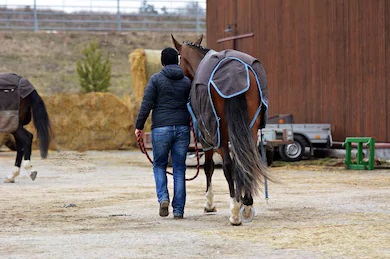Spring is a popular time for new yards to open and established yard owners to review the previous year. This can range from yards based at large equestrian centres to people offering livery at their private yards at home. Competition is fierce for affordable livery; it’s easy to provide competitive livery rates without considering your personal finances or outgoings to run the business. If you don’t correctly price your livery and the services you offer, it may be that you are subsidising the keeping of the horses in your yard!
Below we give some useful advice on calculating what your clients should be paying and what you should be considering when calculating these costs.
Many yard owners base their price on what other livery is available locally, without calculating their own outgoings to see if this is financially viable, with many yards even choosing to undercut the competition. It’s easy to forget that yards may look the same on the outside - offering the same services or facilities in a similar location - yet the management and financial structure can be very different from yard to yard. This can hugely vary and will dictate which yards make money and which don’t.
To calculate what you should be charging you need to include every cost you incur through your business for each livery package, plus a contingency amount to cover price increases or unforeseen costs. You can use the preceding year’s invoices and costs as a guide. Most importantly do not forget to put a value on your own time! It may seem complicated to work out, but with the right information to hand, it should only take a few minutes. To make it easy, at the bottom of the article we have included a ready-to-complete calculation sheet and example calculation.
Unfortunately, you may be surprised by the outcome and find that in fact, it is costing you to run your yard. In which case you will need to raise your charges in line with the costs you have calculated. There is no point ignoring it or making excuses so as not to raise charges because it will make you ‘expensive’ compared to other yards or worrying that you may lose clients.
It is a business, and people run businesses to earn an income. If you are running a yard and working full-time hours on the yard every week, on top of covering your costs, it’s not unreasonable to be expecting to earn a full-time wage! So many yard owners cover their running costs but earn the equivalent of pence per hour for all the hard labour and stress involved with running a yard.
All businesses should undertake an annual review of their earnings and expenditure- it just makes good business sense. Record keeping is key. Having good records of your invoices to clients, and of any expenditure will allow you to see your true costs for the business. Additionally, it's a good opportunity for you to see your outgoings and think of potential ways to bring them down for future years - from changing suppliers to introducing new yard procedures. This can only benefit your business in the long run and increase profitability.
Each stable in a yard will have the same base rate. Regardless if one of your client’s horses is retired and doesn’t use the arena, or one horse has less hay than the horse in the next stable, what you are looking for is an average cost per stable. The next horse in that stable might use the arena twice a day and eat twice as much as its predecessor! Furthermore, remember the calculation sheet allows you to work out your costs and compare them to your livery charges. This does not allow for any profit, so if you want to add profit to your livery business, you should add your preferred profit percentage to your costs - all of which is explained on the calculation sheet below.
Equally, this is an opportunity to review your additional service charges, such as holiday cover or smaller one-off services. For any services you offer, be realistic as to the time and effort it takes to carry these out. In your mind, it may only take a ‘few minutes’ to bring a horse in of an evening, but realistically by the time you’ve walked to the field, caught it, brought it in, hosed its legs off, checked it over, put it in the stable, changed its rug and so on, it's more like 15 minutes, maybe longer if it’s a walk to the fields or they are a pain to catch.
Therefore, you need to ensure you allow for this time used and charge fairly for your labour. If you charge £2 for this service, that’s the equivalent of £8 an hour, less if it takes you more than 15 minutes. Is this an hourly rate you would be happy to work for anywhere else? It is the same for offering exercise. You may well charge a rate for 30 minutes of exercise, but if you must catch, groom and tack up the horse, and then turn it out again afterwards, this is considerably more time than the 30 minutes you are charging for.
Review each of your services on an individual basis. Work out how long each would take on average and base this against what you pay your staff or an hourly rate you’d be happy to work for. If you have clients who use services a lot, a small increase can soon add up and further help cover your yard costs and labour. Moreover, it is a universal fact that costs increase year on year, whether this is insurance, bedding, farrier services, or council rates, they will all rise over time.
As such, like so many other businesses and industries, you should reflect this increase each year. A smaller, expected and well-managed annual increase will be better accepted by clients than a huge leap every few years. Include in your contract a clause that allows you to review, increase, and give notice as such on a fixed date each year. Clients have the same with their home utility bills, council tax and other household costs so there is no reason why they should not be accepting of it for livery services as well. Below is also a template price increase letter to help with your administration if this is a step you need to take.
Overall, spending an hour reviewing your costs and carrying out these calculations can make you a lot better off financially. Any business advisor or accountant would recommend an annual review of any business, and even if you see running your yard as a ‘hobby’, it's worth knowing where you’re at when it comes to your finances. It's no point being the cheapest yard in the area if you may as well be paying your clients to be there!
Example
The following is a very basic example:
Yard X has 10 liveries – all on a DIY basis (stable and grazing rent only).
Based on their previous year's costs, the yard's annual outgoings, including labour, are £15,670.
Adding a 10% contingency (to cover price increases, unforeseen costs, etc) gives a total annual outgoing of £17,237.
Divided by the number of livery spaces (in this example 10) = £1723.70.
Divided by 12 to give a ‘per calendar month’ amount per stable = £143.64.
Based on this calculation, Yard X must be charging a minimum per calendar month of £143.64 (say round up to £145) just to cover their costs.
If, for example, they are only charging £120 per month, they are not even covering their personal costs.
The LiveryList Yard Owner Hub has a huge amount of resources concerning pricing and price increases, including a calculation sheet template to help you calculate your costs, template price increase letters, and a guide to dealing with price increases to make sure not only do you charge the right amount to begin with, but that you continue adjusting your prices accordingly to reflect your costs.



